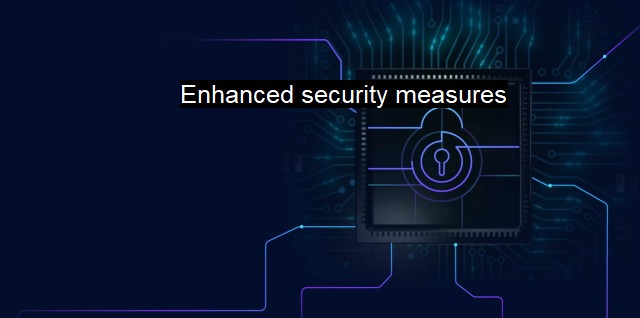What are Enhanced security measures?
Strengthening Your Cybersecurity Posture: The Importance of Enhanced Security Measures in Today's Threat Landscape
"Enhanced security measures" encompass a combination of strategies, controls, policies, guidelines, protocols, and tools that are designed to reinforce the protection of an organization's digital assets, critical data, and network infrastructure against threats, attacks, and unauthorized access. these measures play a key role in safeguarding the information and technology eco-system using multifaceted lines of defense.Cybersecurity refers to the practice of protecting information, devices, networks, and programs from digital threats and attacks aiming at exploiting data without permission. It encapsulates antivirus, an application or software developed specifically to detect, prevent, and act upon malicious activities such as viruses, spyware, adware, worms, trojans, etc. Within this context, enhanced security measures become essential tools to ward off any potential threats and provide an additional layer of security.
These measures can be technological or procedural. Technological enhanced security measures span from encrypted password protocols to high-end firewalls to advanced intrusion detection systems. For instance, secured configurations for hardware and software reduce vulnerabilities and further offer robust protections against cyber threats. Regular updates can repair bugs or security loopholes that could be exploited by cyber attackers. Deploying advanced antivirus software with real-time monitoring can improve hazard detection and remediation processes.
Firewall and intrusion detection/prevention systems forms an important line of defense. While a firewall controls incoming and outgoing network traffic based on an organization's previously determined security policies, an intrusion prevention system screens the network traffic for malicious activities or policy violations. This layered solution augments the security landscape, substantially binds the defense system together, and decreases the chances of an effective cyber first strike.
Apart from these, advanced measures like segmentation or network partitioning help to isolate the network into several segments to curb the spread of threats if one segment is compromised. Implementing two-factor or multi-factor authentication demands multiple credentials to verify a user's identity and reduces the risk of hacking or unauthorized access. Data loss prevention systems monitor, detect, and thwart unauthorized attempts to copy or send sensitive data.
On the other hand, procedural enhanced security measures revolve around policies and training. Policies like standard security protocols, incident response procedures, and emergency processes can effectively guide the organization’s reaction to cyber threats. Ongoing cybersecurity education and training for all employees are critical. It not only sensitizes them to the various types of threats but also educates them on recognizing suspicious activities and responding safely and swiftly.
Enhanced security measures also include constant monitoring and quick response to potential breaches, planning for disaster recovery, conducting regular security audits, and initiating legal action procedures against agitators. Therefore, these strategies should be dynamic and adaptive as per the evolving digital threat landscape. The goal here is a proactive, rather than reactive, approach.
In addition to this, risk assessments, penetration tests, and code reviews can help in identifying vulnerable areas and addressing them before they are exploited. Continual and transparent communication about security measures, their implementation and update can consolidate the trust of stakeholders and augment the overall efficiency and effectiveness of security protocols.
On the whole, "enhanced security measures" are significant in every step of a firm's digital presence – whether it is setting up the IT infrastructure, information management, or responding to a security breach. They constitute an essential investment that reduces the risk of a catastrophic fallout, safeguards intellectual property, maintains customer trust and brand reputation, ensures legal compliance, and guarantees operational continuity.

Enhanced security measures FAQs
What are enhanced security measures?
Enhanced security measures refer to advanced security protocols or methods that are designed to provide higher levels of protection against cyber threats and malware. These measures often involve using sophisticated tools and technologies, such as antivirus software, firewalls, intrusion detection/prevention systems, data encryption, and multi-factor authentication.Why are enhanced security measures important for cybersecurity?
Enhanced security measures are crucial for cybersecurity because they help prevent cyber attacks and data breaches. By deploying advanced security tools and protocols, organizations can significantly reduce their risk of falling victim to cybercrime. This not only protects their sensitive data and assets but also helps maintain customer trust and ensures that their reputation is not tarnished by a security incident.What types of enhanced security measures are commonly used in cybersecurity?
Some of the most commonly used enhanced security measures in cybersecurity include antivirus and anti-malware software, firewalls, intrusion detection/prevention systems, data encryption, multi-factor authentication, network segmentation, and vulnerability assessments. These measures are typically deployed in combination to provide multiple layers of security and help detect and prevent different types of cyber threats.How can organizations implement enhanced security measures effectively?
Organizations can implement enhanced security measures effectively by first conducting a comprehensive risk assessment to identify their vulnerabilities and potential threats. Based on this assessment, they can then develop a security strategy that includes a combination of technical, administrative, and physical controls. It's also essential to establish policies and procedures for detecting and responding to security incidents, as well as training employees on safe cyber practices. Regular security audits and testing can help ensure that the implemented security measures are effective and up to date.| | A | | | B | | | C | | | D | | | E | | | F | | | G | | | H | | | I | | | J | | | K | | | L | | | M | |
| | N | | | O | | | P | | | Q | | | R | | | S | | | T | | | U | | | V | | | W | | | X | | | Y | | | Z | |
| | 1 | | | 2 | | | 3 | | | 4 | | | 7 | | | 8 | | |||||||